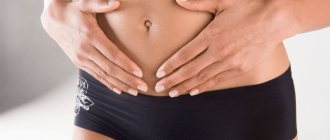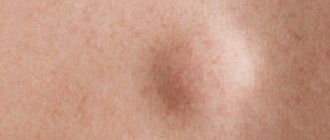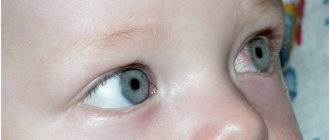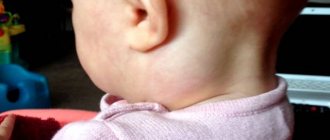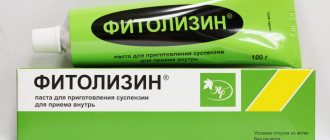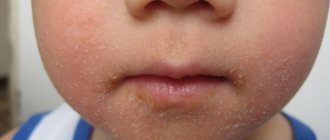Causes of purulent discharge
The pathological contents of the navel appear due to the entry of infectious agents into the soft tissues. The condition can develop under the influence of internal causes and external factors.
The reasons for the formation of pus in adults and children differ.
In newborns
The baby's umbilical cord serves as a transport channel during the prenatal period. Through it, nutrients flow from the mother to the fetus through the bloodstream.
After birth, the connection is interrupted and the umbilical cord is cut off. In its place, a wound forms with a remnant of the navel, which under normal circumstances dries up, disappears without pus and pain in 4-7 days.
In case of pathology, the wound becomes wet, does not heal, hurts, and turns red. Omphalitis typically appears two weeks after the birth of the child.
Suppuration of the navel in a newborn occurs for the following reasons:
- Incorrect care. Pediatricians of the Soviet school recommend treating the wound with brilliant green and hydrogen peroxide. Modern family doctors insist on natural healing of the navel. Recommendations are individual for each situation. Failure to follow the doctor's advice may result in omphalitis.
- Diaper related overheating. The wound heals better in the fresh air. Diapers interfere with ventilation, creating favorable conditions for the proliferation of pathogenic microorganisms that cause inflammation with pus.
- Redness and suppuration of the navel can be caused by staphylococci and streptococci. They are activated when the child’s immunity is reduced, usually in premature babies.
Typical signs of omphalitis are redness of the skin, increased body temperature, the child is constantly restless due to painful sensations, and a cloudy exudate appears inside the wound.
Pus in a baby's navel requires consultation with a pediatric neonatologist. Newborns with weak immune systems quickly develop dangerous complications.
In adults
Omphalitis is considered a childhood disease, but discharge from the navel can begin at any age.
Typically, inflammation develops due to damage to the skin in this area.
Need advice from an experienced doctor?
Get a doctor's consultation online. Ask your question right now.
Ask a free question
Possible causes of pus in an adult’s navel:
- Insufficient hygiene. Often the pit on the stomach is not given enough attention. It collects dirt, dust, sweat, and pieces of clothing. The components create favorable conditions for the proliferation of pathogenic microorganisms: fungi, viruses, bacteria, which causes inflammation.
- Pus from the navel in women can be a consequence of piercing. The puncture injures the skin; swelling, especially in the case of poor quality care, can develop into a pathological process.
- Abdominal injury. If after the injury the wound begins to get wet and does not begin to heal within a week, you need to consult a doctor.
Factors in the formation of exudate can be eliminated, preventing pathology.
Careful care of the navel at any age is an effective prevention of the appearance of pus.
Symptoms
To correctly determine the cause of pain in the abdomen, doctors and parents should pay attention to several characteristics of the course of the disease. This:
- What time of day does your tummy hurt most often? In the morning, at night or all the time. Morning discomfort indicates intestinal infections, the presence of worms, nervous disorders, appendicitis. Night pain is characteristic of colic in newborns. Constant discomfort accompanies constipation or hernia.
- Duration of attacks. If the pain goes away after a day, the pain covers the abdominal cavity for a short period of time, then we are talking about flatulence or indigestion. If complaints do not disappear and get worse every day, you need the help of a doctor.
- Where does your stomach hurt? If discomfort and pain are felt in the center of the abdomen, near the navel, most likely there is no danger to the baby’s life. For pain in the low and upper peritoneum, discomfort lasting more than a day, a more accurate diagnosis of the causes of deterioration in well-being is required.
- How my stomach hurts. The peritoneum can hurt sluggishly, with sudden attacks, contractions, aching or pulling. The most dangerous for babies are paroxysmal cramps that occur periodically throughout the day. This is a symptom of intussusception, intestinal blockage, and volvulus of internal organs. If the stomach is seething, there is diarrhea, then we are talking about poisoning or an intestinal infection.
- The child's appearance. Skin color and the presence of rash are important. Paleness, itching, rashes on the back, legs, and face should cause concern.
- General health of the patient.
Decreased performance, apathy, lethargy, cough, physical inactivity, sweating are signs of inflammatory and infectious processes. If a child constantly cries, refuses to eat, or cannot sleep for a long time, he probably has colic. The baby cannot complain of pain, so the mother will have to guess the reasons for the hysteria and malaise; it is better to do this together with the doctor. - Is there vomiting and nausea? These are alarming symptoms, but they should concern parents only if they occur for a long time. If your child vomits once or twice, you may suspect an upset stomach. If symptoms occur repeatedly, nausea for more than a day, or blood in the vomit, consult a doctor. Nausea along with diarrhea, pain above and below the navel indicate peritonitis or intestinal hernia.
- Appearance and frequency of stool. Delayed bowel movements and diarrhea should cause concern. If blood, mucus, or foam is visible in the stool, medical attention is required urgently. Diarrhea with an infectious disease lasts three days, with a viral infection - one to two days. Diarrhea for more than three days is a dangerous symptom.
- Is there an increase in temperature? If pain in the middle or lower abdomen is accompanied by a fever above 38°C, then there is no need to panic. There may not be any serious problems. Concerns should be caused by pain without fever, nausea, vomiting, or diarrhea.
- Did you experience pain when walking? Teenagers often complain of discomfort in the peritoneal area when walking quickly. This is a symptom of abdominal muscle strain associated with exercise or coughing. If there are no other signs of illness, there is no need to worry.
- Dependence of the occurrence of attacks on food intake.
If the stomach begins to hurt, belching appears, heaviness after eating, gastritis or irritable bowel syndrome may be suspected. If the pain does not depend on meals and is cramping in nature, the baby has inflammation or an infection. - Child's age. In infants, an acute attack of pain occurs due to colic and intestinal kinks. In girls during puberty, discomfort in the abdominal area is felt lower due to the onset of menstruation.
- Is there a wound in the navel area? If a fistula or abdominal injury is suspected, an external examination of the patient is important. If there are wounds or scratches, it means that the baby fell and hit the peritoneum. If the doctor or mother notices a hole in the umbilical ring, the cause of the pain is a fistula.
Which doctor should I contact and how to treat the disease
Pediatricians, therapists, and surgeons treat pus in the navel area. The specialist’s profile and treatment tactics depend on the form of the pathology.
In medical practice, there are three types of omphalitis in adults and children. Downtime is manifested by local symptoms and does not affect the patient’s well-being. Serous discharge drains and dries to form a crust.
The simple form is treated by daily washing the affected area with antiseptics: Furacilin, hydrogen peroxide. The use of disinfectant solutions alternates with the application of antibacterial ointments. These include drugs based on tetracycline and erythromycin. The cavity with pus is treated with brilliant green and potassium permanganate.
Dr. Komarovsky advises not to forget about the hypertrophic form of the pathology. Sometimes pink granulations grow in the wound on the navel, which will stick out on the skin. Cones are cauterized in a hospital setting with silver nitrate.
Phlegmonous and necrotic forms of omphalitis are advanced conditions, accompanied by high body temperature, chills, discharge of pus from the wound, and an unpleasant odor. Gangrene develops in the inflamed area. Both forms require inpatient monitoring. Treatment includes conservative and surgical methods.
A patient with complaints of omphalitis undergoes examination. They do a bacteriological examination of pus, general clinical tests of blood and urine. Laboratory diagnostic methods will help select pathogenetic treatment for the disease.
An abscess on the navel in the phlegmonous and necrotic stages is treated surgically. The doctor uses local anesthesia, cuts the outer wall of the formation, and evacuates the pus. Drainage is placed in the wound to prevent the accumulation of exudate. The surgeon performs the procedure for 15-30 minutes.
In women, men, and children, the healing time of the postoperative area varies. The speed of recovery depends on the person’s immunity, the severity of the condition, and complications.
From the moment the diagnosis is confirmed, the patient is prescribed penicillin and cephalosporin antibiotics. The drugs are administered by injection or orally.
The prognosis of the disease is favorable. After the evacuation of pus and healing of the wound on the navel, the patient returns to the normal rhythm of life.
When do you need a doctor?
You should seek medical help if your child experiences the following suspicious symptoms along with abdominal pain:
- Diarrhea, vomiting, especially if the baby is less than 3 months old.
- Constipation and vomiting at the same time.
- Feces, vomit with blood.
- The pain began abruptly and was felt acutely.
- The abdomen is painful and hard.
- The child is breathing frequently and intermittently.
- The baby complains of difficulty urinating.
- Boys feel pain in the testicles, scrotum, and groin.
- The child had a tummy injury.
- The patient is being treated for cancer and recently completed a course of therapy.
If the pain is sharp or the condition quickly worsens, call an ambulance. In less dangerous situations, you can get by by going to the clinic.
Prevention in children
To prevent the appearance of pus in the navel area in a newborn or omphalitis in adults:
- The baby's wound should be treated with clean hands.
- The diaper is wrapped inward in the abdominal area. To prevent the appearance of pus, the skin must be in contact with air.
- If the remaining umbilical cord is contaminated, rinse it with distilled or boiled water, then dry it with a clean towel.
- Adults need to pay attention to hygiene. Daily washing of the navel prevents pathogenic flora from multiplying.
- After the piercing procedure, you need to monitor the condition of the wound and regularly treat it with antiseptics. Itching, pain, and redness are typical symptoms of infection.
- If pus appears, do not self-medicate, consult a doctor.
- A strong immune system prevents the development of inflammation. A balanced diet rich in vitamins improves the body's protective functions.
Pus in the navel area responds well to treatment, but it is better to prevent the appearance of pathology and monitor the condition of the skin to prevent omphalitis.
The article has been reviewed by the site editors
First aid
If a child complains of pain in the abdominal area or feels unwell, first aid must be provided before the doctor arrives. To alleviate the condition at home, parents can do the following:
- Provide the baby with peace and long sleep if necessary. Lay him on the bed, bend his knees. If your child doesn't mind, tuck a pillow under your feet.
- Take the baby in your arms. Hold him close, carry him around the house, calm him down. Do not make sudden bends when vomiting; hold the newborn upright for belching and passing gases.
- Give the baby a belly massage. For colic, place the baby on his back and stroke the navel clockwise. Then bend your knees, gently press it to your stomach, repeat five to ten times - the gas should go away, the pain will become weak and dull.
- If constipation is the cause of discomfort, do an enema.
- Let's drink liquid in small portions.
- Apply ice to the area of pain for a few minutes.
- Take your temperature.
- Monitor your stool and the frequency of vomiting.
- Call an ambulance if the pain does not go away after one to two hours or if it suddenly intensifies.
What not to do before the doctor arrives
- Relieve discomfort with painkillers, inject medications without prescriptions.
- Force feed.
- Give extra fluids when vomiting and nausea occurs.
- Warm the area of pain with compresses.
Prevention methods
To avoid complaining about your tummy, you need to take preventive measures to reduce the risk of disruptions in the functioning of the stomach and intestines. You need to start during pregnancy. Hernias, fistulas, small intestine cancer and other pathologies are congenital. The expectant mother should follow a pregnancy diet, lead a healthy lifestyle, and avoid stress.
After the birth of a child, it is recommended to organize the baby’s nutrition, rhythm of life and daily routine as follows:
- Provide five meals a day


